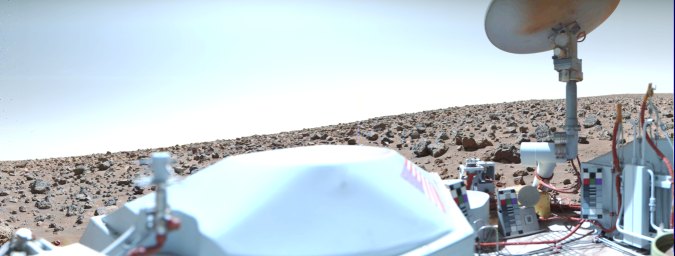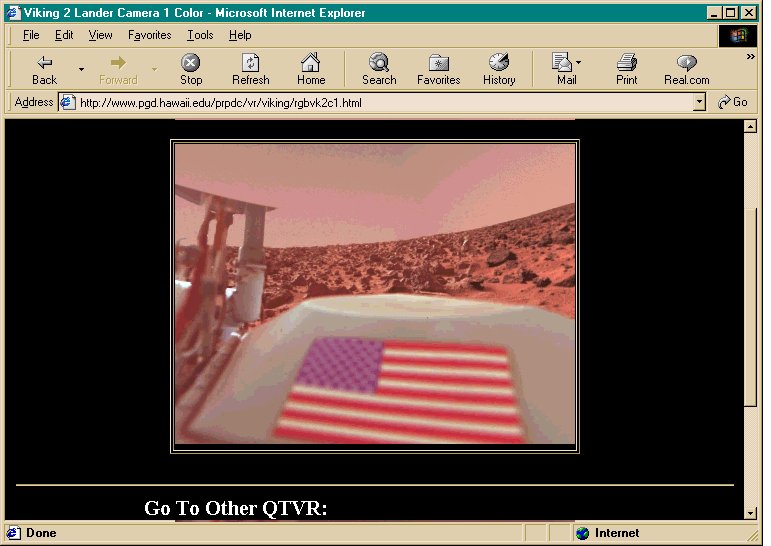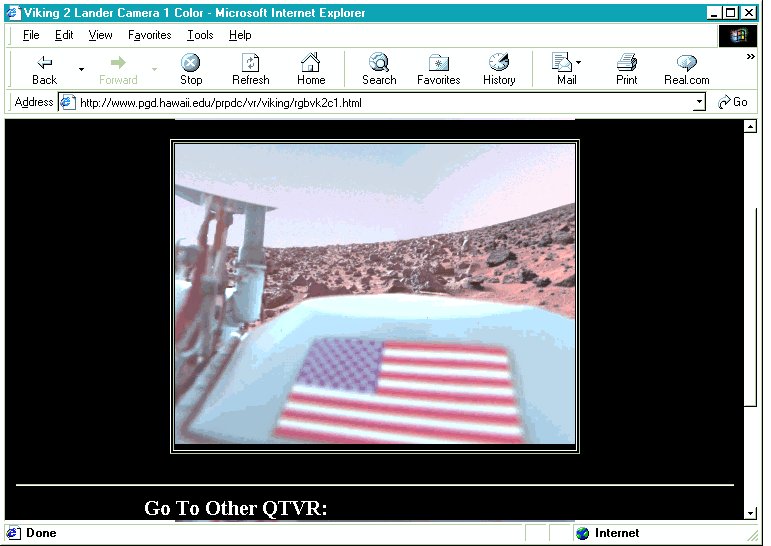-
- Comment
- From Alan J. Adams
aladams@teksystems.com
3-14-1
-
- Jeff,
-
- There is a way to find out what the appropriate set of
colors for those photos are, and although I am not skilled enough with
the software to do it myself, I may know someone who is.. Are there any
known photos of the lander in a terrestrial environment. press pictures
or the like that show the lander in a known environment so that the colors
in the lander could be derived?
-
- Once one has that, they could take the known colors and
apply them to the gamma equalization of the image, this would make the
lander white, if the sky is greatly different, I.E. still red, then it
has been altered the sky should be about the same color as the lander since
the lander is white, and as you would see the lander would take on a blue
tint from the sky. you would use flags, staffs etc. on the lander as other
color "landmarks" to verify this information. It is a fairly
easy process for someone with the appropriate graphics software. If one
were to measure the amount of any one color from the black in the image
it is also a reference.
-
- This is a fairly easy process for someone with these
skills. That will give us a good Idea of who is right and who is keeping
us in the dark red.
- -----
-
-
- Original Article
-
-
- I don't know if you and Kim know about this controversy
over the Martian red-sky vs. blue-sky.
-
- Note that Ron Levin is a physicist at MIT. His father
Gil Levin was the Principal Investigator on the Viking labeled release
experiment to test for life.
-
- Vincent Di Pietro's remarks worth paying attention to.
Di Pietro (and Gregory Molinaar) were the first ones to find the two (different)
"face on Mars" pictures in the NASA files. _____
-
- From G. G. Ford <swimp@home.com Subject: Viking Mars
Lander Color finagling revealed Date: Tue, Apr 25, 2000
-
- Quotd from: http://www.mufor.org/dipietro3.html
-
- [Start Quote]
-
- From: LanFleming@aol.com Date: Sun, 4 Oct 1998 To: cydonia@majordomo.pobox.com
-
- Below is a message I sent to SPSR members. I got an interesting
response from Vince DiPietro, which I will send separately to the list.
-
- I recently listened to a RealAudio interview from the
Laura Lee Show archive that was done last July. The guests were Dr. Gil
Levin (PI for the Labeled Release experiment on the Viking landers) and
his son, Ron, who is a physicist at MIT. I'm sure you're all familiar with
Dr. Gil Levin's story, but his son described something that I had never
heard before:
-
- Ron said that he was a 20-year old grad student and was
at JPL when the first color images came in from the lander. He said those
original images showed a blue sky and rocks with greenish patches on them,
and that the Viking imaging team quickly adjusted the images so that the
sky and the rocks all had the reddish color we're familiar with. Levin
made it clear that there was no scientific justification for these "adjustments",
and he speculated that the color
-
- was changed because the planetary scientists took a dim
view of the greenish patches on the rocks, which suggested some primitive
form of plant life might be growing right on the surface.
-
- This story sounded like one of those tall tales, except
for the person who was telling it. Ron Levin is a physicist at MIT who
co-authored his father's recent paper on the LR experiment and liquid water
on Mars. He's not one of those anomymous "sources" that are responsible
for most of the wild stories, so I took his allegations seriously enough
to find out more about the original Viking images.
-
- The first images released to the media on the day of
the Viking 1 landing did, in fact, show a blue sky, but the later ones
showed a red sky. There are several "authoritative" explanations
of what happened, one involving color filters that were passing "out
of band" light, making the images come out too blue. (Malin says this
on one of his web pages). This doesn't sound plausible to me, since I would
think they certainly would have noticed any major problem with the filters
in the exhaustive preflight testing of the hardware.
-
- Ron Levin also said something else that surprised me:
that the Hubble Space Telescope had taken images of Mars that showed a
blue sky. I checked the HST web site, http://oposite.stsci.edu/pubinfo/subject.html
-
- Sure enough, every last one of the higher-resolution
images of Mars shows a bluish band around the limb of the planet that looks
very much like a blue sky. Also, the Hubble scientists issued periodic
weather reports on Mars up to the Pathfinder landing, and these reports
explicitly predicted that Pathfinder should see a blue sky.
-
- Hubble's last "weather report" before the Pathfinder
landing states:
-
- "If dust diffuses to the landing site, the sky could
turn out to be pink like that seen by Viking," says Philip James of
the University of Toledo. Otherwise, Pathfinder will likely show blue sky
with bright clouds." (URL http://oposite.stsci.edu/pubinfo/pr/97/23/PR.html)
-
- There was no indication that any dust storms were active
in the area. Surface measurements made by the spacecraft reported only
light winds for many days after the landing. Yet all the images that came
back from Pathfinder showed the same red sky as Viking had.
-
- I saw one NASA web page that claimed this confirmed that
the colors shown by Viking were correct (a subject they seem rather sensitive
about). If Ron Levin is correct, then there are "problems" with
the Pathfinder images as well as Viking. The Hubble press releases certainly
suggest that there is a real difference of opinion that goes well beyond
Levin.
-
- I'm not totally convinced that the blue band around the
limb shown in the Hubble images is really sky, because the band is about
2 pixels deep, the best of which had a resolution of 13 miles. If the blue
band is atmosphere, then it would mean that it is thick enough up to altitudes
above 13 miles to back- scatter enough light for the Hubble camera to detect
it.
-
- I measured some photographs taken by space shuttle astronauts
of the Earth's limb, and the atmospheric haze visible in the photos is
only 22 miles deep at most. Earth's atmosphere is 100 times more dense
than Mars' at ground level, and the altitude where the Earth's atmospheric
haze disappears (22 miles) is about the point where the density of the
atmosphere drops to that of Mars at its greatest density at ground level.
Mars does have about 1/3 the albedo of Earth, so maybe the lower brightness
of the martian surface doesn't swamp the light from Mar's tenuous atmospheric
haze. If this blue band is NOT sky, I can't think of anything else it could
be other than some kind of chromatic aberration in the camera. So this
might not be the reason that the Hubble scientists concluded that the sky
should be blue, but they definitely had SOME reason to think that, in contradiction
to JPL.
-
- One final thing that is worth a comment: I also looked
at one of the few wide- angle color photographs Malin has released that
shows the limb of the planet. I really would think it should show something,
but there is not the slightest hint that Mars has any atmopshere at all
in this in this image, blue OR red. The transition from the red surface
to the blackness of space is as abrupt as in images of the Moon.
-
- __
-
- This is the message I got in response from Vince DiPietro,
which he gave me permission to distribute. Vince goes quite a bit farther
with his comments than just the Viking lander.
-
-
- Lan,
-
- During September, 1996, I was in communication with John
Green, an engineering technician at the Univ. of Kentucky. John sent away
for the first pictures of the lander (PIC ID 77/10/11/182339) SKL/L2964BX
from JPL. JPL sent the uncorrected version and the "PAINT YOUR WAGON
RED" version. John also sent for the images data fields on diskette.
John claims that the three color guns were set at nominal voltages, somewhere
about mid-range on the uncorrected version. The "painted" version
has the red gun of the spacecraft turned all the way up, and the explanation
given by JPL was lame. I have been talking about this at all of my lectures
for
-
- the past two years, but of course the gospel according
to Saint JPL has been that the red version was correct. I say that JPL
is putting out garbage. THIS IS NOT SCIENCE! What is needed here is a full
blown investigation of JPL MARS activities for the past twenty-two years
by someone like Ken Starr. A letter from SPSR to the Senate sub-committee
on Space should be considered at this time. I still maintain that the reason
that JPL has done this is for fear of losing their funding to Manned-Flight
to Mars. All of the life indicators from Mars have been either ignored
or put down by JPL. In no particular order these are:
-
- 1. The Face and all anomalies in Cydonia
-
- 2. The Organic Fossils in meteorites in two centuries
Aug.7,1996 ALH84001 meteorite July 20,1989 Dr. Ian Wright-EETA79001 meteorite
1966 Dr. Bart Nagy-Revelstoke, Orgueil, Ivuna meteorites 1881 Dr. Hahn
- Knyahinya meteorite
-
- 3. Dec.,1980 The Water Geyser in Solis Lacus- Dr. Leonard
Martin
-
- 4. Since 1976 - Dr. Gil Levin - Labeled Release Experiment
-
- 5. The very, very white rock found at Pathfinder site
named "Casper" which might have been calcium carbonate or a bone
fragment. JPL skirted all around this rock, and never gave us an analysis.
-
- I believe that we are dealing with thugs, like the guy
who wanted to fist-fight me in Boston at the AGU conference in May of this
year. How long will we allow JPL to get away with this witchcraft?
-
- Vince
-
- Comment
- From Michael Portaro
IndyBoosler@Mac.com
4-26-00
-
-
- Hello Jeff,
-
- I had to comment on the story "Viking Mars Lander
Photo Color-Altering Revealed".
-
- Back in 1976 I was a wide-eyed nine year old who was
fascinated with the space program. I watched every bit of space coverage
that was on TV going back as far as I can remember. I watched at least
3 or 4 of the Apollo missions, Apollo-Soyuz in 1975. I think I even watched
the launch of either Viking or Voyager.
-
- The day that Viking landed on Mars in 1976 I watched
live as the pictures from Mars were transmitted all over the world, and
Jeff, as sure as a 9 year olds' recollection 24 years later can possibly
be, that sky WAS BLUE!
-
- I even remember doing a crayon drawing of what I saw
and I certaintly used blue for the sky. I remember that when I saw the
pictures later in life, it didn't look like I'd remembered it, but I didn't
think much of it, chalking it up to a 9 year olds imagination. Unfortunately
I don't remember seeing any greenish patches on the rocks - I was probably
taken more by the sky and how it resembled Earth.
-
- Take care Michael Portaro Clarkston MI
-
-
-
- Comment
-
-
- From Kevin Daly
kdalynz@iol.ie
4-27-00
-
- I recall well myself seeing the first Viking images in
1976, complete with blue sky (this was a big event for us, because we'd
had to listen to the first moon landing on the radio since New Zealand
didn't have a satellite receiving station in 1969).
-
- I was 15 at the time, and I also remember quite clearly
when the corrected versions were released shortly afterwards. As well as
I can remember the explanation was along the lines that the blue coloration
had been the result of the imaging software applying terrestrial default
values (since the images were received in greyscale originally). To be
honest, this sounded like a perfectly reasonable explanation at the time
and still does.
-
- Whatever conspiracies may or may not be active with regard
to Mars, I don't see any reason to believe that the colour of its sky is
part of one of them.
-
- Actually, I remember that after getting over my initial
disappointment at the loss of the impressive and surprising blue sky, the
first sight of a truly *alien* sky was an experience that helped make the
universe a more interesting place for me.
-
- Kevin Daly
Dublin, Ireland
-
-
- Comment
- From Ira Oehler
IOehler@asapauto.com
4-27-00
-
- Jeff,
-
- While reading that story in your headlines, one other
obvious possibility came to mind: perhaps the earth-like blue sky and earth-like
mossy rocks indicate the photos were actually taken on earth and not Mars
at all. I wonder how the guys (levin, Dipeitro, etc) in the article could
be so sure that they were really looking at photographs/video footage of
Mars and not remote areas of the Earth (Antarctica for instance)?
-
- Ira
-
-
- Comment
Frances
Hmmmm Jeff,
-
- Me thinks someone else is TRYING to stir up ANOTHER controversy
using you and your site as a vehicle to do it.
-
- I have a book here, published in 1981,82 called "The
New Solar System", authored by J. Kelley Beatty, Brian O'Leary and
Andrew Chaikin, with intro by Carl Sagan. This book shows LOTS of photos
taken by Voyager and Viking 2 Lander etc... Some are in colour but most
are black and white. Anyhow I managed to find THREE pictures taken by those
craft back in the 1970s that ARE in colour AND show the sky (because the
other colour pictures seem to be pointed down at the surface and you don't
see the sky) and the sky is ORANGY PINK in 2 of the 3 pictures. The other
one remaining picture shows a whitish sky (kind of like what it looks like
here on a hazy or overcast day). That picture though does not only show
green on the rocks, which looks if not like vegetation but at least like
fungus or mold, but ALSO frost patches on the ground! The other two pictures
are pretty much representative of the pictures we've all become familiar
with, with the latests Mars Lander probe. So I don't think JPL "added
or changed" the colour to the pictures. I'm sorry but I'm not buying
into that one.
-
- Frances
|


